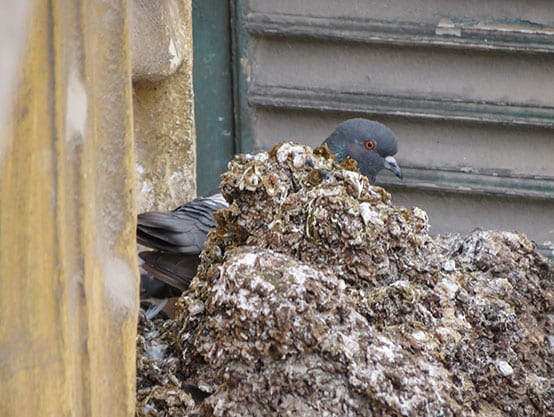
by Pigeon Patrol | May 31, 2021 | 4-S Gel Bird repellent, Animal Deterrent Products, Bird Deterrent Products, Bird Law, Pigeons, Raccoons, Sparrows, UltraSonic Bird Control
There’s been a few charges laid around town but there is one individual who is causing more headaches than normal
The pigeon problem in Kirkland Lake is so bad, police felt the need to issue a news release this morning warning residents to follow the law when dealing with them.
The town started renting out traps to residents today to capture pigeons, and police say that trappers will be responsible for the disposal of the birds, which includes a ban on throwing them in the garbage for curbside pickup. Successful trappers will instead have to take the pigeons for burial at the town dump.
“The OPP want to inform the residents that it is each individual’s responsibility to educate themselves on this topic and to ensure that they are acting within the laws, regulations and town by-laws,” says Constable Adam Gauthier.
The problem started, says Ashley Bilodeau, Kirkland Lake’s Manager of Planning and Land Development, when a few bird lovers started feeding the pigeons.
“We have a couple of residents that have been obnoxiously feeding pigeons to the point where we have some serious problem areas, so we passed a no-feeding bylaw back in the fall,” she told BayToday. “However, there is one individual who just continues to feed them despite the bylaw and has been charged. There’s been a few charges laid around town but there is one individual who is causing more headaches than normal.”
The fine for feeding is steep at $100, and that’s down from the $250 the town wanted to charge but the province wouldn’t allow it.
“So we’re trying to find different ways to combat the issue because it’s now causing problems to people’s properties and vehicles because there are so many of them.”
Bilodeau says the town has checked with the MNRF and it’s not illegal to kill pigeons although you are required to have a small game licence in order to trap and kill pigeons.
The town has not placed a limit on the number of pigeons people can capture, but police warn folks can’t use their guns to shoot the birds because discharging a firearm is prohibited within the Town of Kirkland Lake,
Bilodeau says poop is the problem.
“They’re also causing damage to buildings by trying to build nesting areas,” she adds. “We’ve got four traps here and people can come in and put in a deposit and take the trap for 10 days, and when they bring it back they get their money back.”
Pigeons were originally bred from the wild rock dove, which naturally inhabits sea-cliffs and mountains according to Wikipedia, so the bird finds the ledges of buildings to be a substitute for sea cliffs.
They have become abundant in towns and cities throughout the world. Due to their abilities to create large amounts of excrement and to carry disease, combined with crop and property damage, pigeons are largely considered a nuisance with steps being taken in many municipalities to lower their numbers or completely eradicate them.
Source
Pigeon Patrol Products & Services is the leading manufacturer and distributor of bird deterrent (control) products in Canada. Pigeon Patrol products have solved pest bird problems in industrial, commercial, and residential settings since 2000, by using safe and humane bird deterrents with only bird and animal friendly solutions. At Pigeon Patrol, we manufacture and offer a variety of bird deterrents, ranging from Ultra-flex Bird Spikes with UV protection, Bird Netting, 4-S Bird Gel and the best Ultrasonic and audible sound devices on the market today.
Voted Best Canadian wholesaler for Bird Deterrent products ten years in a row.
Contact us at 1- 877– 4– NO-BIRD, (604) 585-9279 or visit our website at www.pigeonpatrol.ca
Pigeon/Pigeon Patrol / Pigeons Roosting / Vancouver Pigeon Control /Bird Spikes / Bird Control / Bird Deterrent / Pigeon Deterrent? Surrey Pigeon Control / Pest /Seagull deterrent / Vancouver Pigeon Blog / Birds Inside Home / Pigeons in the cities / Ice Pigeons/ What to do about pigeons/ sparrows , Damage by Sparrows, How To Keep Raccoons Away, Why Are Raccoons Considered Pests/ De-fence / Pigeon Nesting/ Bird Droppings / Pigeon Dropping/ woodpecker control/ Professional Bird Control Company/ Keep The Birds Away/ Birds/rats/ seagull/pigeon/woodpecker/ dove/sparrow/pidgeon control/pidgeon problem/ pidgeon control/flying rats/ pigeon Problems/ bird netting/bird gel/bird spray/bird nails/ bird guard
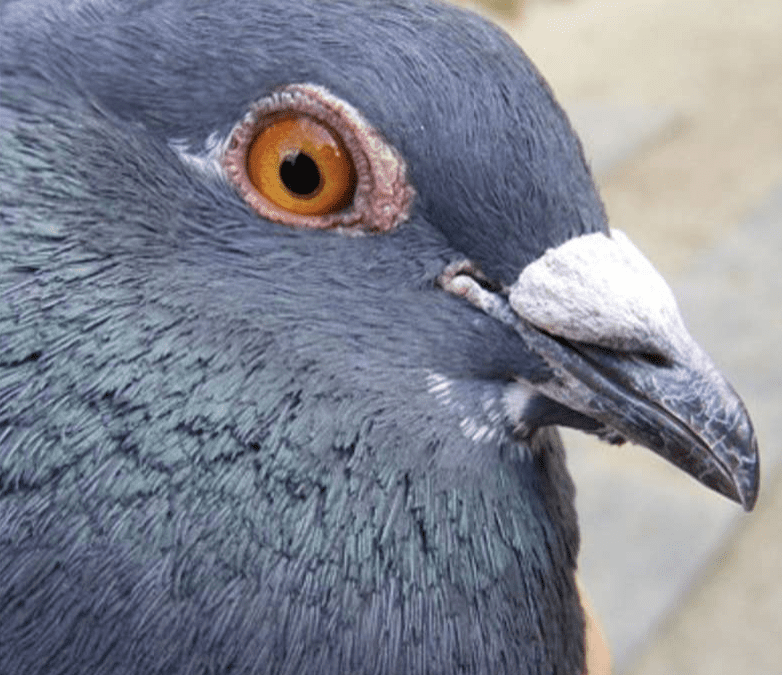
by Pigeon Patrol | Apr 26, 2021 | Columbidae, Pigeon Spikes, Pigeons in the News, UltraSonic Bird Control
Many of us have heard of the Lost Battalion, and know some of the story. What is not commonly known is the role of a remarkable pigeon, named Cher Ami. That little bird became one of the greatest heroes of World War I.
Cher Ami at the Smithsonian Institution. (Photo by Armed Forces History, Division of History of Technology, National Museum of American History)
Cher Ami was one of almost 600 carrier pigeons employed by the US Army Signal Corps during the First World War. Carrier pigeons were invaluable , in spite of the advances in communications technology during the war. Radios were not as reliable since they were large and still bound by delicate wires. It also was not always possible to lay new wires quickly, and often could be extremely dangerous. While not necessarily a popular form of communication, pigeons did prove a reliable one. The average homing pigeon can fly approximately fifty miles per hour, making them a quick method of communication. Still, these pigeons often proved popular targets to enemy gunfire despite their speed. In fact, German machine gunners trained diligently to both spot and kill these birds with their deadly MG 08s, which could fire over 500 rounds per minute. Pigeons could also be a very risky way to communicate, because if a pigeon was shot down, the message could easily be intercepted by enemy forces.
The US Army Signal Corps used some 600 pigeons in WW1.
It was during the Meuse-Argonne Offensive of 1918 where the carrier pigeon was finally recognized for its valiant efforts. On October 2nd, 1918, American soldiers from the 77th Division pushed too far into the Argonne Forest and became trapped behind German lines on the slopes of a hill. Cut off from reinforcements and supplies, roughly 550 men from the 306th, 307th, and 308th regiments under Major Charles Whittlesey held their ground against a far larger German force for several days. Far beyond radio range, the only way the Americans could communicate with their own lines was via carrier pigeon. However, it did not take long to realize that the skies were as dangerous as the ground. Trapped in a horrible meatgrinder of machine guns and rain, the Lost Battalion held their ground against vicious German attacks.
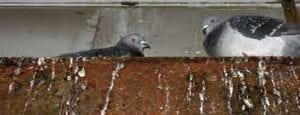
On October 4th, American heavy artillery started to bombard the Lost Battalion’s position on accident, killing thirty men as they held the line. Major Whittlesey and his men watched as bird after bird fell out of a sky torn apart by German fire. With supplies running out and casualties mounting rapidly, Major Whittlesey desperately sent out his last pigeon, Cher Ami, to the American lines with a note that simply read, “We are along the road parallel to 276.4. Our own artillery is dropping a barrage directly on us. For heaven’s sake, stop it.” With fire raining down on them from all sides, Cher Ami was now the last chance for the Lost Battalion to walk off that hill alive.
Capt John Carney, Cher Ami’s trainer, holds the feathered hero.
The brave bird flew straight into the German fire, dodging bullets as he went. However, his luck did not last for long. Cher Ami was hit in the chest soon after takeoff, as American soldiers watched in horror as their last hope hit the ground. Against all odds though, Cher Ami got up again! Wounded but still alive, the little bird took flight again, charging head-on into wave after wave of gunfire. By the end of the trip, he covered 25 miles in roughly half an hour. He arrived at base heavily wounded, but alive.
The Croix de Guerre with Palm military decoration of France, awarded to Cher Ami.
Army medics were able to save Cher Ami’s life, but his right leg was barely attached to his body and he was blind in one eye. However, because of Cher Ami’s delivery, the artillery stopped and took up new firing coordinates away from American lines. The next day, shells started to fall on German positions, relieving pressure on the bloodied 77th and the battle turned in America’s favor. On October 8th, one hundred and ninety-four men made it back to the American lines thanks to Cher Ami’s sacrifice.
For his part in saving the 77th Division, Cher Ami was awarded the Croix de Guerre, one of France’s highest military honors for his gallantry in the field. General John Pershing, commander of the American Expeditionary Force, said “There isn’t anything the United States can do too much for this bird.”
Cher Ami made it back to the United States in the care of its trainer, Capt John Carney. On June 13th, 1919, Cher Ami died at Fort Monmouth, New Jersey. However, Cher Ami’s body was preserved and presented to the American Government with honor. It is difficult to say how many families owe their existence to the sheer courage and self-sacrifice of one brave bird. Today, Cher Ami is on display at the Smithsonian Museum of American History to preserve his memory. Since then, his story has lived on in the hearts and minds of Americans across the decades, and his bravery will never be forgotten.
Pigeon Patrol Products & Services is the leading manufacturer and distributor of bird deterrent (control) products in Canada. Pigeon Patrol products have solved pest bird problems in industrial, commercial, and residential settings since 2000, by using safe and humane bird deterrents with only bird and animal friendly solutions. At Pigeon Patrol, we manufacture and offer a variety of bird deterrents, ranging from Ultra-flex Bird Spikes with UV protection, Bird Netting, 4-S Bird Gel and the best Ultrasonic and audible sound devices on the market today.
Voted Best Canadian wholesaler for Bird Deterrent products ten years in a row.
Contact us at 1- 877– 4– NO-BIRD, (604) 585-9279 or visit our website at www.pigeonpatrol.ca
Pigeon/Pigeon Patrol / Pigeons Roosting / Vancouver Pigeon Control /Bird Spikes / Bird Control / Bird Deterrent / Pigeon Deterrent? Surrey Pigeon Control / Pest /Seagull deterrent / Vancouver Pigeon Blog / Birds Inside Home / Pigeons in the cities / Ice Pigeons/ What to do about pigeons/ sparrows , Damage by Sparrows, How To Keep Raccoons Away, Why Are Raccoons Considered Pests/ De-fence / Pigeon Nesting/ Bird Droppings / Pigeon Dropping/ woodpecker control/ Professional Bird Control Company/ Keep The Birds Away/ Birds/rats/ seagull/pigeon/woodpecker/ dove/sparrow/pidgeon control/pidgeon problem/ pidgeon control/flying rats/ pigeon Problems/ bird netting/bird gel/bird spray/bird nails/ bird guard
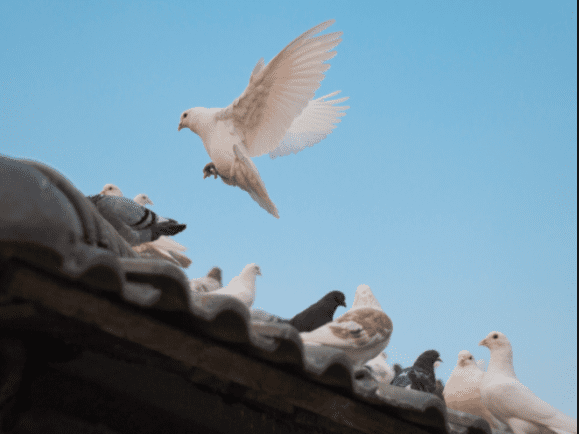
by Pigeon Patrol | Feb 9, 2021 | Animal Deterrent Products, Bird Deterrent Products, Bird Law, Bird Netting, Bird Spike, Bird Spikes, Pigeon Patrol's Services, Pigeon Spikes, Pigeons, UltraSonic Bird Control
Bird control technicians’ nightmare – what to do when we are asked to do the impossible? The straight answer is that there is really nothing we can do when pigeons land on your roof, but there is much more to know.
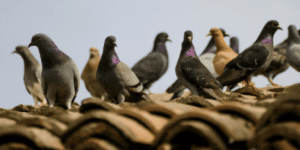
Many customers ask: “Why? Why my roof, what’s so special about my roof that they have to land there?” Believe it or not you are asking the right question: Why? Once you understand why, you will also understand why is it hard to provide a solution in this situation.
Almost always, the primary cause of such problem is the availability of food nearby, plenty of it on a regular basis. Probably someone is feeding the birds or there are lots of garbage in the area or open garbage bins/containers. They could also nest or roost in close proximity and simply they use your roof as a comfy perching spot having a nice vantage point over their feeding area.
What could we do? Install hundreds of feet of spikes on your roof? Put up scary owls? Maybe speakers on the roof peak? Unfortunately none of them are viable. It is simply not feasible to protect large, flat (horizontal or sloped) roof surfaces, such as the entire roof of a victorian house for example.
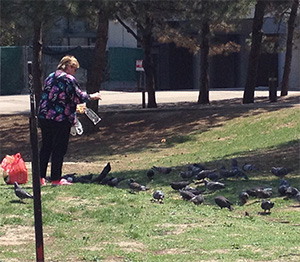
Lady feeding the pigeons in College Park – every day.
First, we need to find ways of eliminating food and water sources nearby. Then we must find their nesting/roosting areas – which will most likely be on another property, otherwise you would see them somewhere else on your house/building, (in which case it would be very easy to resolve the issue,– that provides sheltered structural configurations to establish a protected area where they can stay at night. Pigeons don’t see well at night and usually they go to their roosting spots before nightfall and stay there during the night.
If protecting these areas are not possible (because they are on someone else’s property) we can look at strategically installing Bird Spikes or exclusion Bird Netting or the combination of both, maybe Electric Tracks at critical areas to discourage them from landing on your roof.
You can see now that there aren’t any straightforward solutions in the case of house roof tops and that it is very time consuming to address the issue holistically. The best thing you can do is to call up a professional and get an opinion, you might have missed something that a pro will notice that could help resolve the issue.
source
Some other options for bird repellent would be the Ultrasonic Sound Repellent which makes noises that can only be heard by pigeons and scare them off with the sound or the laser beam which can be activated by movement or you can time when these lasers come on. These lasers are too strong for the pigeons vision to handle and they will fly elsewhere. You can purchase these here : https://www.pigeonpatrol.ca/product/laser/
Pigeon Patrol Products & Services is the leading manufacturer and distributor of bird deterrent (control) products in Canada. Pigeon Patrol products have solved pest bird problems in industrial, commercial, and residential settings since 2000, by using safe and humane bird deterrents with only bird and animal friendly solutions. At Pigeon Patrol, we manufacture and offer a variety of bird deterrents, ranging from Ultra-flex Bird Spikes with UV protection, Bird Netting, 4-S Gel and the best Ultrasonic and audible sound devices on the market today.
Contact us at 1- 877– 4– NO-BIRD, (604) 585-9279 or visit our website at www.pigeonpatrol.ca
Pigeon / Pigeon Patrol / Pigeons Roosting / Vancouver Pigeon Patrol / Bird Control / Surrey Pigeon Control / Pest /
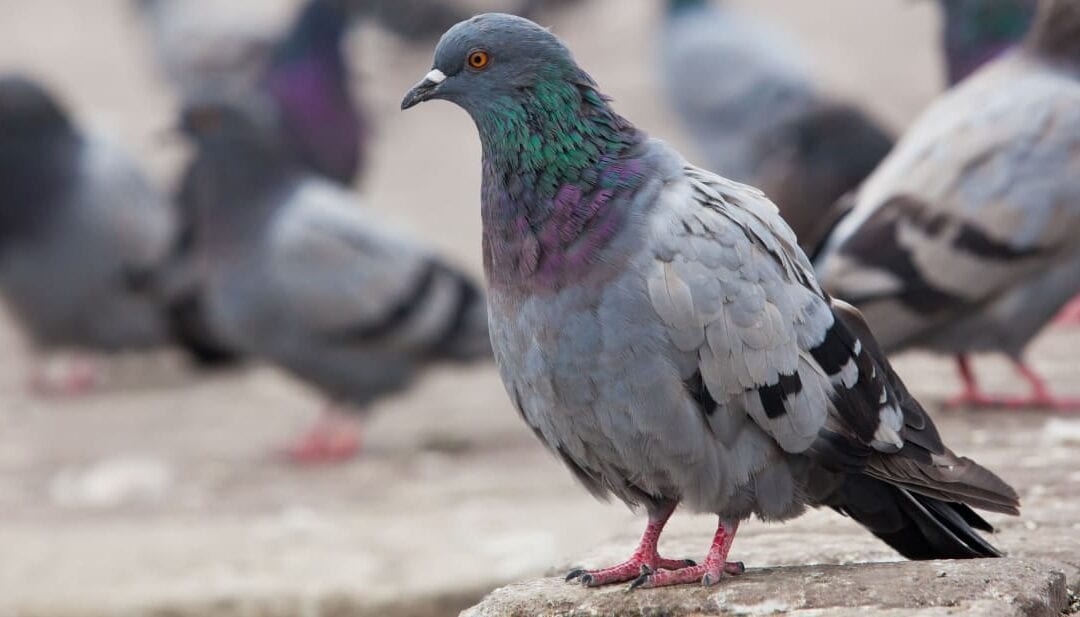
by Pigeon Patrol | Feb 9, 2021 | Animal Deterrent Products, Bird Deterrent Products, Bird Spikes, Columbidae, UltraSonic Bird Control
Sound Deterrent For Birds
Ultrasonic pigeon & bird scarers are electronic devices that produce high pitch emissions known as ultrasound. Ultrasonic pigeon & bird scaring systems have been introduced into the pest control marketplace due to the fact that ultrasound is too high-pitched for human hearing but falls within the hearing range of most species of birds. Most sonic bird scaring devices produce a sound that is audible to the human ear and therefore may cause human disturbance if used in an area of human habitation.
Pest birds can quickly become a costly problem to property owners and managers. The birds will gather in increasingly large flocks to deface and damage property and equipment. Lethal means of bird control—poisons, pellet guns and inhumane traps—are illegal in many areas, since many birds are protected by law. Today’s advanced sound bird deterrents can be highly effective as a humane way to deter pest birds.
How It Works
Ultrasonic repellents work differently than other deterrents. They use high frequencies (which the human ear cannot hear) to deter birds and other pests. When the birds or pests hear the sound being produced, they become disoriented or irritated by the noise. Birds also quickly learn to avoid areas where they have felt the ultrasonic sound waves
There are many ultrasonic devices to choose from depending on the coverage you need. Typically, they are able to cover up to 3,600 sq. ft. With multiple speakers, you can customize coverage for even larger areas.
Distress & Predator Calls Intimidate Birds
Many types of birds such as pigeons and seagulls have a specific “distress call.” Birds will emit these sounds only when they are attacked by a predator. Sound bird deterrents intimidate pest birds by broadcasting these prerecorded distress and predator calls. The devices have been scientifically designed to fully exploit a bird’s natural alertness and sensitive hearing—hearing that’s similar to humans. Social and aggressive birds that communicate verbally within colonies will often fly towards theses distress calls to see if they can mob the predator and come to the aid of their fellow bird. When the calls temporarily cease and no predator is found, the arriving birds are frightened by the possible danger and disperse.
The Sounds Bird Hear
Sound bird deterrents operate within the normal hearing range of most birds—about 1 to 4 kHz—although birds can hear higher and lower frequencies to a limit of 20 kHz. Unlike the ultrasonic sounds emitted by some high frequency “bird deterrents,” the sounds emitted by sound bird deterrents resemble normal birdcalls to the human ear, which is why they won’t annoy pets or neighbors—only birds.
Programmable Output
Birds, like people, can get accustomed to sounds, even those they may initially perceive as threatening. This is why the best sound bird deterrents can be programmed to emit threatening birdcalls for several minutes, stop and then repeat the sequence every 10 minutes. These devices will also feature a volume control that allows the sound intensity of birdcalls to be adjusted—from 65-105 decibels.
Different Sounds for Different Birds
The best sound bird deterrents will have the flexibility to broadcast distress and predator calls for as many as 24 different types of birds. These systems allow users to target a specific bird or all birds. Such systems can even be programmed to turn on and off automatically. They will also allow additional speakers to be added to extend the effective deterrent range from one acre to five acres. source
Pigeon Patrol Products & Services is the leading manufacturer and distributor of bird deterrent (control) products in Canada. Pigeon Patrol products have solved pest bird problems in industrial, commercial, and residential settings since 2000, by using safe and humane bird deterrents with only bird and animal friendly solutions. At Pigeon Patrol, we manufacture and offer a variety of bird deterrents, ranging from Ultra-flex Bird Spikes with UV protection, Bird Netting, 4-S Gel and the best Ultrasonic and audible sound devices on the market today.
Contact us at 1- 877– 4– NO-BIRD, (604) 585-9279 or visit our website at www.pigeonpatrol.ca
Pigeon / Pigeon Patrol / Pigeons Roosting / Vancouver Pigeon Patrol / Bird Control / Surrey Pigeon Control / Pest /
Sound Deterrent For Birds
Vancouver Pigeon Blog / Birds Inside Home / Pigeons in the cities / Ice Pigeons/ What to do about pigeons/ most common types of sparrows , Damages Caused by Sparrows, How To Keep Raccoons Away, Why Are Raccoons Considered Pests?de-fence, Pigeon Nesting and Breeding Patterns and Behavior What Do I Do With a Bird Trapped in My Wall? Professional Bird Control Company Keep The Birds Away From Your Business Why Are Raccoons Considered Pests? Sound Deterrent For Birds
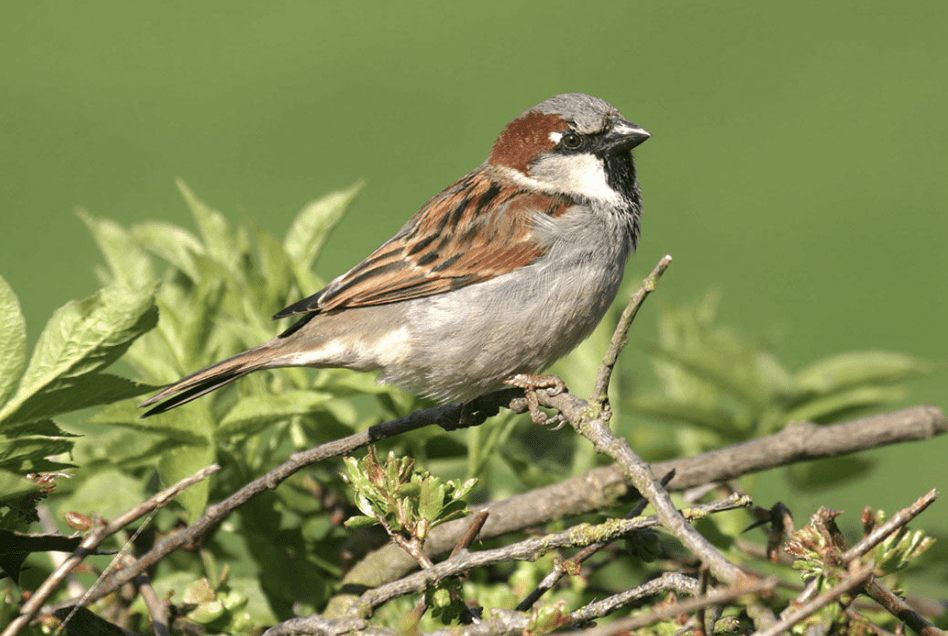
by Pigeon Patrol | Dec 7, 2020 | Animal Deterrent Products, Bird Deterrent Products, Bird Netting, Pigeon Patrol's Services, Pigeon Spikes, Pigeons in the News, UltraSonic Bird Control
Looking to learn more about sparrows? Keep on reading to find out 10 sparrow facts!/am-tree-sparrow-58ca9fc73df78c3c4f9a3610-5a0e0f3a9e942700377f9e72.jpg)
Sparrow is a species of small Passerine birds, also acknowledged as True sparrows or Old world Sparrows. It originates from North Africa and is also found in Asia, Australia, Europe, New Zealand and North America. Sparrows cannot be found in forests or deserts, unlike other birds. It prefers being in close association to human settlement, including urban and rural areas. They inhabit on ideal sparrow habitat nesting on buildings, roofs, and houses.
Sparrows are brown-grey chubby birds. They have short tails with stubby and powerful beaks. These are effortless flying birds with small size and bodies. These creatures make their way to the air creating a splendid sight to see. Sparrows are considered to be extreme vocal birds of all times. The sizes of these birds vary according to the region they inhabit. Sparrows are similar to other seed-eating birds except they possess an extra bone in tongue and an outer primary feather. On the other hand, cheeky sparrows have a diverse range of colors varying from sandy blonde to a rich red color. source
10 Sparrow Facts
- Sparrows have both genders males and females which can be easily distinguished by feather coloration. Females possess brown backs with stripes while males possess reddish backs and black bibs.
- Sparrows are said to be the social creatures. They live in colonies which are commonly mentioned to as flocks.
- Sparrows are primarily carnivorous by nature i.e. they are meat eaters. They learn to change their eating habit more frequently while they live in close association with Sparrows primarily eat moths and also feed on small insects. They can also feed on seeds, fruits, and berries.
- Sparrows easily adapt to the life in human settlements due to the constant supply of food. These creatures learn to eat food which they are provided by the people when people build their bird feeders.
- They usually fly at the speed of about 24 miles per hour, in the case of emergency they can speed up to 31 miles per hour.
- Although sparrows are not considered as water birds, they swim at a very fast pace to escape from predators.
- Predators of sparrows are usually dogs, cats, foxes and snakes. The young new ones are an easy target for these carnivores.
- Sparrows are not included in territorial animals, but they are aggressively protective about their nests from other sparrows.
- Sparrow is considered to be a very small Its length can vary between 4-8 inches and weighs around 0.8 to 1.4 ounces. With such small bodies, they can easily fit into the small openings.
- It possesses a stout body with rounded wings. Its body is covered with brown, black and white feathers.
About Pigeon Patrol:
Pigeon Patrol Products & Services is the leading manufacturer and distributor of bird deterrent (control) products in Canada. Pigeon Patrol products have solved pest bird problems in industrial, commercial, and residential settings since 2000, by using safe and humane bird deterrents with only bird and animal friendly solutions. At Pigeon Patrol, we manufacture and offer a variety of bird deterrents, ranging from Ultra-flex Bird Spikes with UV protection, Bird Netting, 4-S Gel and the best Ultrasonic and audible sound devices on the market today.
Contact us at 1- 877– 4– NO-BIRD, (604) 585-9279 or visit our website at www.pigeonpatrol.ca
Pigeon / Pigeon Patrol / Pigeons Roosting / Vancouver Pigeon Patrol / Bird Control / Surrey Pigeon Control / Pest / Vancouver Pigeon Blog / Birds Inside Home / Pigeons in the cities / Ice Pigeons/ What to do about pigeons/ most common types of sparrows
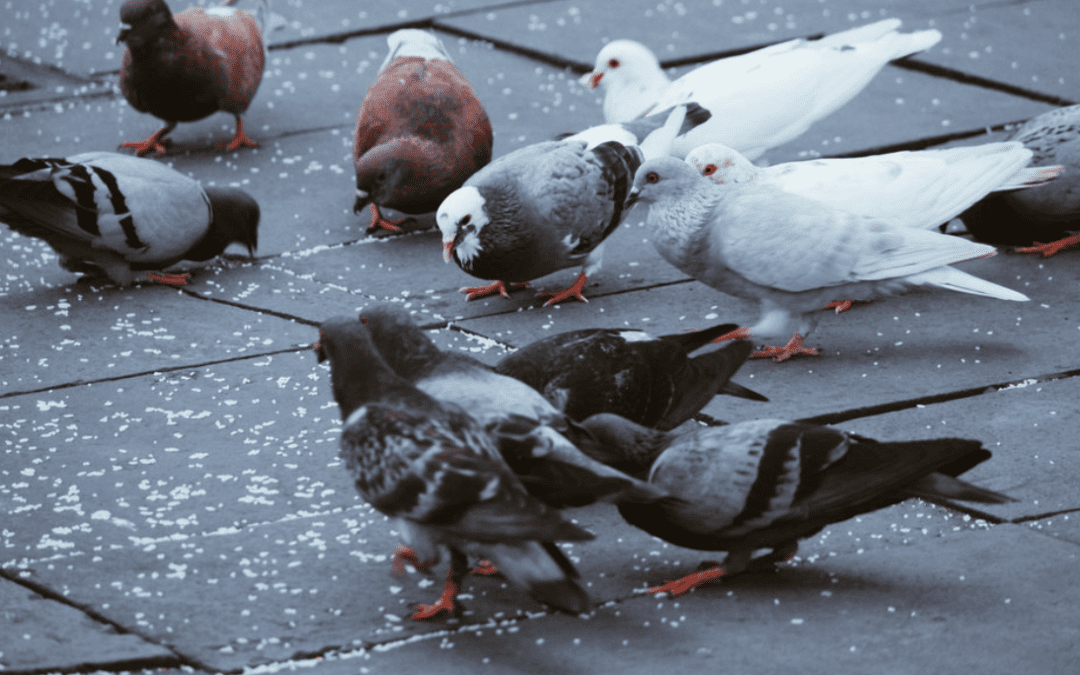
by Pigeon Patrol | Nov 29, 2020 | 4-S Gel Bird repellent, Animal Deterrent Products, Bird Deterrent Products, Bird Netting, Pigeon Patrol's Services, Pigeon Spikes, Pigeons in the News, UltraSonic Bird Control
Ever heard of the bird flu? Keep on reading to find out more about what it is!
So what is the bird flu?
The Bird Flu also known as the Avian influenza refers to the disease caused by infection with avian (bird) influenza (flu) Type A viruses. These viruses occur naturally among wild aquatic birds worldwide and can infect domestic poultry and other bird and animal species
When was the bird flu?
The year 2005 has been dubbed ‘the year of bird flu’. Across the globe, the fear of avian influenza has caused government officials to place a higher priority on developing plans to deal with pandemic influenza. A survey published on 23 December 2005 by the World Health Organization (WHO) named avian influenza as the number one health concern. This heightened concern exists despite any evidence suggesting sustained human-to-human transmission of the potentially pandemic H5N1 strain of avian influenza virus. Experts have been closely monitoring occurrences of H5N1 since it first appeared in 1996 in the Chinese province of Guangdong.
The number of confirmed human H5N1 infections doubled in 2005. Of the 142 cases of human H5N1 influenza reported as of 30 December 2005, over half have been fatal. That statistic sparked a media frenzy that H5N1 may develop into the next pandemic strain of influenza. A serological survey published in the Journal of Infectious Disease by Bridges et al. (185, 1005–1010, 2002) showed that although the incidence of human H5N1 infection might be higher than previously thought, the mortality rate might be much lower. Up to 10% of 1,525 asymptomatic poultry workers had antibodies to the H5N1 virus. Most of these human cases are thought to have developed after contact with infected animals. Documented reports suggest that H5N1 can infect many bird species and mammals, in addition to humans. Although more serological studies in affected areas are needed, the 2002 study suggests the virus can infect humans without producing the extreme mortality commonly associated with the H5N1 strain. Yet the fear remains that mutation or reassortment of viral genomic segments with those of other endemic strains of influenza might result in a highly virulent human virus.
The WHO, the US Centers for Disease Control and Prevention and the United Nations Food and Agriculture Organization have established extensive surveillance and reporting programs for H5N1 influenza. The year 2005 witnessed an explosion of H5N1 outbreaks in poultry and migrating wild bird populations in Asia, spreading to Russia and eastern Europe. That dissemination occurred despite massive vaccine inoculation programs for poultry initiated by local governments in Asia and culling of infected bird flocks elsewhere. Although not yet reported, experts have expressed concern over the appearance of H5N1 in Africa, where surveillance and control measures are subject to regional conflicts, thereby heightening the risk that a highly transmissible human form of H5N1 virus might evolve. Thus, a race against time is now on to develop and generate effective human vaccines to prevent H5N1 infection and to produce sufficient amounts of antiviral drugs that might lessen disease severity. Therapies aimed at controlling innate immune responses should also be pursued, given the clinical evidence that H5N1 elicits ‘cytokine storms’ that can contribute to disease pathogenesis.
Is all the news dire? No. In fact, the present threat of pandemic influenza has spurred several encouraging steps. There seems to be greater accountability in disease surveillance by local health authorities, who supply critical field samples to international agencies that constitute the WHO Influenza Surveillance Network. The WHO has established several laboratories dedicated to analyzing new isolates of influenza virus, thereby providing much-needed standardized epidemiological information on viral samples obtained from geographically separate regions and monitoring how the virus is evolving from earlier isolates. Should a pandemic strain of human influenza arise, these laboratories can quickly identify the relevant ‘genomic fingerprint’ and advise vaccine manufacturers.
Another welcome consequence of the focus on avian influenza has been a resurgence of interest in vaccine manufacturing. Because which H5N1 influenza isolate will have the ‘right’ combination of mutations that allows it to spread quickly throughout human populations cannot be predicted in advance, vaccine manufacturers need to develop new means for rapid production of effective vaccines. At present, methods for the production of influenza vaccines require billions of chicken eggs, a resource that might be unavailable given the lethality of the virus in avian species. The use of reverse genetics in vaccine design as well as mass production using vaccine-certified cell lines hold the promise of streamlining production schedules and reducing potential bottlenecks based on the availability of eggs. The WHO and the US National Institutes of Health have several recombinant H5N1 prototype vaccine strains derived by reverse genetics from viral isolates from southeast Asia. Both agencies have provided these clones to licensed manufacturers for the development and testing of vaccines, some of which have already entered clinical trials. Governmental licensing agencies need to expedite their review process for vaccines produced by cell-based manufacturing methods. Sufficient incentives or collaborative partnerships must be extended to vaccine manufacturers to retool their production facilities so they can meet the global demand for viral vaccines.
Yet planning for the possibility of a future pandemic must also be done on the local level. As witnessed by the SARS outbreak in 2003, substantial economic consequences can result from the mere threat of a highly transmissible disease. It is imperative that local governments, businesses and other institutions develop and test contingency plans that can be deployed in their communities should a pandemic strain arise. Such contingency plans should be independent of vaccination programs (vaccination with the present viral formulations should be encouraged) or antiviral prophylaxis for exposed people, as no guarantee can be made that sufficient supplies of such agents would be available. These plans should include infection-control measures, identification of essential personnel and possible alternative work procedures (such as telecommuting), and a means of communication to rapidly disseminate critical information. All community members should be educated on the specifics of their plan and what to do in the event of such a health emergency. Such planning might avoid future revisionists from proclaiming 2006 as the year of bird flu. Source

The virus continued to kill chickens and to occasionally infect and sometimes kill people. But as the years passed, the number of human H5N1 cases subsided. There has not been a single H5N1 human infection detected since February 2017. This is the good news
About Pigeon Patrol:
Pigeon Patrol Products & Services is the leading manufacturer and distributor of bird deterrent (control) products in Canada. Pigeon Patrol products have solved pest bird problems in industrial, commercial, and residential settings since 2000, by using safe and humane bird deterrents with only bird and animal friendly solutions. At Pigeon Patrol, we manufacture and offer a variety of bird deterrents, ranging from Ultra-flex Bird Spikes with UV protection, Bird Netting, 4-S Gel and the best Ultrasonic and audible sound devices on the market today.
Contact us at 1- 877– 4– NO-BIRD, (604) 585-9279 or visit our website at www.pigeonpatrol.ca
Pigeon / Pigeon Patrol / Pigeons Roosting / Vancouver Pigeon Patrol / Bird Control / Surrey Pigeon Control / Pest / Vancouver Pigeon Blog / Birds Inside Home / Pigeons in the cities / Ice Pigeons


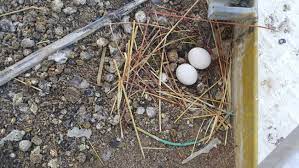







/am-tree-sparrow-58ca9fc73df78c3c4f9a3610-5a0e0f3a9e942700377f9e72.jpg)


